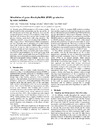Identificador persistente para citar o vincular este elemento:
https://accedacris.ulpgc.es/jspui/handle/10553/75479
| Campo DC | Valor | idioma |
|---|---|---|
| dc.contributor.author | Galí, Martí | en_US |
| dc.contributor.author | Saló, Violeta | en_US |
| dc.contributor.author | Almeda García, Rodrigo | en_US |
| dc.contributor.author | Calbet, Albert | en_US |
| dc.contributor.author | Simó, Rafel | en_US |
| dc.date.accessioned | 2020-11-12T17:52:55Z | - |
| dc.date.available | 2020-11-12T17:52:55Z | - |
| dc.date.issued | 2011 | en_US |
| dc.identifier.issn | 0094-8276 | en_US |
| dc.identifier.uri | https://accedacris.ulpgc.es/handle/10553/75479 | - |
| dc.description.abstract | Oceanic gross DMS production (GP) exerts a fundamental control on the concentration and the sea‐air flux of this climatically‐active trace gas. However, it is a poorly constrained process, owing to the complexity of the microbial food web processes involved and their interplay with physical forcing, particularly with solar radiation. The “inhibitor method”, using dimethyldisulfide (DMDS) or other compounds to inhibit bacterial DMS consumption, has been frequently used to determine GP in dark incubations. In the work presented here, DMDS addition was optimized for its use in light incubations. By comparing simultaneous dark and light measurements of GP in meso‐ to ultraoligotrophic waters, we found a significant enhancement of GP in natural sunlight in 7 out of 10 experiments. Such stimulation, which was generally between 30 and 80% on a daily basis, occurred throughout contrasting microbial communities and oceanographic settings. | en_US |
| dc.language | eng | en_US |
| dc.relation | MICROROL - Role of microzooplankton in marine food webs dynamics: functional diversity, relevance in C, N and P cycles and trophic impact on primary producers (CTM2004-02575/MAR) | en_US |
| dc.relation | SUMMER (CTM2008‐ 03309) | en_US |
| dc.relation | Expedición de Circunnavegación Malaspina 2010: Cambio Global y Exploración Del Océano Global | en_US |
| dc.relation.ispartof | Geophysical Research Letters | en_US |
| dc.source | Geophysical Research Letters [ISSN 0094-8276], v.38, n. 15 | en_US |
| dc.subject | 251001 Oceanografía biológica | en_US |
| dc.subject.other | Dimethyldisulfide | en_US |
| dc.subject.other | Dimethylsulfide | en_US |
| dc.subject.other | Dimethylsulfoniopropionate | en_US |
| dc.subject.other | Gross DMS production | en_US |
| dc.subject.other | Microbial community | en_US |
| dc.subject.other | Solar radiation | en_US |
| dc.title | Stimulation of gross dimethylsulfide (DMS) production by solar radiation | en_US |
| dc.type | info:eu-repo/semantics/article | en_US |
| dc.type | Article | en_US |
| dc.identifier.doi | 10.1029/2011GL048051 | en_US |
| dc.identifier.issue | 15 | - |
| dc.investigacion | Ciencias | en_US |
| dc.type2 | Artículo | en_US |
| dc.description.numberofpages | 5 | en_US |
| dc.date.coverdate | 13 agosto 2011 | en_US |
| dc.identifier.ulpgc | No | en_US |
| dc.contributor.buulpgc | BU-BAS | en_US |
| dc.description.sjr | 3,113 | |
| dc.description.jcr | 3,792 | |
| dc.description.sjrq | Q1 | |
| dc.description.jcrq | Q1 | |
| dc.description.scie | SCIE | |
| item.fulltext | Con texto completo | - |
| item.grantfulltext | open | - |
| crisitem.project.principalinvestigator | Hernández León, Santiago Manuel | - |
| crisitem.author.dept | GIR ECOAQUA: Ecofisiología de Organismos Marinos | - |
| crisitem.author.dept | IU de Investigación en Acuicultura Sostenible y Ecosistemas Marinos (IU-Ecoaqua) | - |
| crisitem.author.dept | Departamento de Biología | - |
| crisitem.author.orcid | 0000-0002-0090-112X | - |
| crisitem.author.parentorg | IU de Investigación en Acuicultura Sostenible y Ecosistemas Marinos (IU-Ecoaqua) | - |
| crisitem.author.fullName | Almeda García, Rodrigo | - |
| Colección: | Artículos | |
Citas de WEB OF SCIENCETM
Citations
35
actualizado el 12-ene-2026
Visitas
92
actualizado el 10-ago-2024
Descargas
85
actualizado el 10-ago-2024
Google ScholarTM
Verifica
Altmetric
Comparte
Exporta metadatos
Los elementos en ULPGC accedaCRIS están protegidos por derechos de autor con todos los derechos reservados, a menos que se indique lo contrario.
